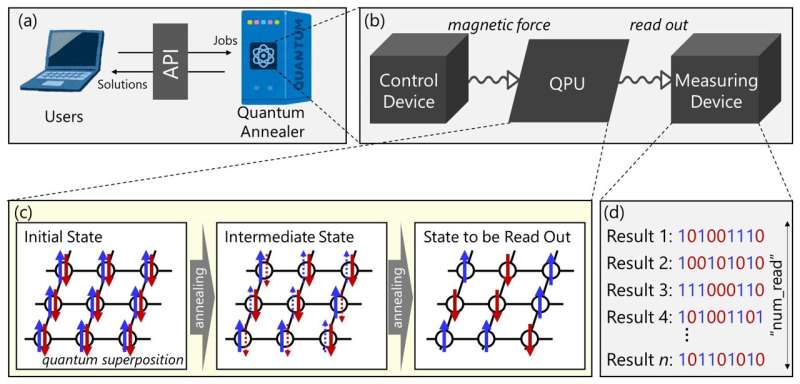A conceptual image of the quantum annealing. Credit: Nonlinear Processes in Geophysics (2024). DOI: 10.5194/npg-31-237-2024
Data assimilation is a mathematical discipline that integrates observed data and numerical models to improve the interpretation and prediction of dynamical systems. It is a crucial component of Earth sciences, particularly in numerical weather prediction (NWP).
Data assimilation techniques have been widely investigated in NWP in the last two decades to refine the initial conditions of weather models by combining model forecasts and observational data. Most NWP centers around the world employ variational and ensemble-variational data assimilation methods, which iteratively reduce cost functions via gradient-based optimization. However, these methods require significant computational resources.
Recently, quantum computing has emerged as a new avenue of computational technology, offering a promising solution for overcoming the computational challenges of classical computers.
Quantum computers can take advantage of quantum effects such as tunneling, superposition, and entanglement to significantly reduce computational demands. Quantum annealing machines, in particular, are powerful for solving optimization problems.
In a study, published in Nonlinear Processes in Geophysics, Professor Shunji Kotsuki from the Institute for Advanced Academic Research/Center for Environmental Remote Sensing/Research Institute of Disaster Medicine, Chiba University, along with his colleagues Fumitoshi Kawasaki from the Graduate School of Science and Engineering and Masanao Ohashi from the Center for Environmental Remote Sensing, developed a novel data assimilation technique designed for quantum annealing machines.
"Our study introduces a novel quantum annealing approach to accelerate data assimilation, which is the main computational bottleneck for numerical weather predictions. With this algorithm, we successfully solved data assimilation on quantum annealers for the first time," explains Prof. Kotsuki.
In the study, the researchers focused on the four-dimensional variational data assimilation (4DVAR) method, one of the most widely used data assimilation methods in NWP systems. However, since 4DVAR is designed for classical computers, it cannot be directly used on quantum hardware.
Prof. Kotsuki says, "Unlike the conventional 4DVAR, which requires a cost function and its gradient, quantum annealers require only the cost function. However, the cost function must be represented by binary variables (0 or 1). Therefore, we reformulated the 4DVAR cost function, a quadratic unconstrained optimization (QUO) problem, into a quadratic unconstrained binary optimization (QUBO) problem, which quantum annealers can solve."
The researchers applied this QUBO approach to a series of 4DVAR experiments using a 40-variable Lorentz-96 model, which is a dynamical system commonly used to test data assimilation.
They conducted the experiments using the D-Wave Advantage physical quantum annealer, or Phy-QA, and the Fixstars Amplify's simulated quantum annealer, or Sim-QA. Moreover, they tested the conventionally utilized quasi-Newton-based iterative approaches, using the Broyden-Fletcher-Goldfarb-Shanno formula, in solving linear and nonlinear QUO problems and compared their performance to that of quantum annealers.
More information: Shunji Kotsuki et al, Quantum data assimilation: a new approach to solving data assimilation on quantum annealers, Nonlinear Processes in Geophysics (2024). DOI: 10.5194/npg-31-237-2024
Provided by Chiba University
























